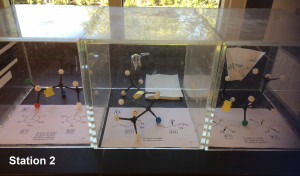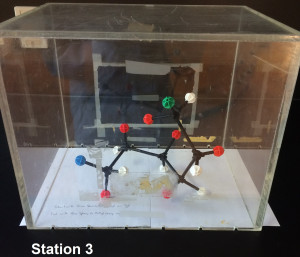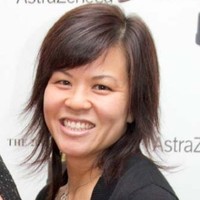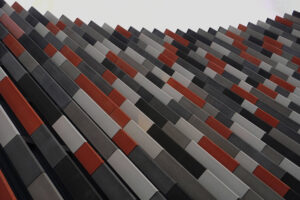Do You Know Your Stereochemistry?

At a Glance
Discipline
- STEM
- Chemistry
Instructional Level
- College & CEGEP
- University
Course
- Organic Chemistry
Tasks in Workflow
Social Plane(s)
- Individual
- Group
Type of Tasks
- Solving problems
- Taking a quiz & test
Technical Details
Class size
- Small (20-49)
Time
- Single class period (< 90 mins)
Instructional Purpose
- Assessment & knowledge refinement
Overview
The aim of this activity is to test the students’ understanding of the relationships between different stereoisomers and their 3D visualization skills of organic molecules using a two-stage test.
Just before class, the instructor sets up the activity in a laboratory space.
One set of 3 different stations are set up around the classroom (setup A), while another set of 3 stations, that are slightly different, are also setup around the classroom (setup B).
The stations from setup A are interspersed with the stations from setup B, with maximum spacing in between the stations. This is to ensure that during class time, groups working on the same set of stations cannot hear each other’s answers.
The stations are covered (they are only revealed at the start of Part 2 of the two-stage test).
During the lecture time, students complete a Two-stage test.
- Part 1: A written 20 minute individual assessment containing stereochemistry questions. Students submit their answers at the end of Part 1.
- Part 2: Students form groups of 3 to 4 and participate in a group assessment for the next 30 minutes. Half of the groups visit setup A and the other half visit setup B. Groups visit each station (for 10 minutes each) and answer the corresponding questions. Each group submits their answers at the end of Part 2 once they have visited all the stations.
 All the questions to be answered for Part 2 are provided on a sheet of paper which each group is given. The stations are as follows:
All the questions to be answered for Part 2 are provided on a sheet of paper which each group is given. The stations are as follows:
- Station 1: A bond-line drawing of a complex organic molecule. Students are asked to identify whether the designated carbons are chiral (up to 12) and determine the configuration of each stereocenter (R or S).
- Station 2: Three different displays all containing: 1 molecular model and 1 pair of molecular drawings (either Newman projection, Fischer projection or bond-line structure), ideally all encased in a transparent plastic box. For each display, students are asked to identify the relationship between the pair of drawings (enantiomers, diastereomers, or constitutional isomers) and which drawing represents the 3D model without touching the model.
 Station 3: A molecular model of a long carbon chain with various substituents. Students are asked to draw a Fischer projection of the model starting with a particular group on top and ending with a particular group on the bottom, without touching the model.
Station 3: A molecular model of a long carbon chain with various substituents. Students are asked to draw a Fischer projection of the model starting with a particular group on top and ending with a particular group on the bottom, without touching the model.
For the two stage test, there is a flexible grading scheme: either 85% individual and 15% group or 100% individual; whichever is the highest.
After class, the instructor will post solutions online, including pictures of all the 3D models. Each picture will be matched up with the corresponding molecular drawing.
Instructional Objectives
- To improve 3D visualization skills for organic molecules;
- To identify relationships between stereoisomers;
- To apply different molecular 3D drawing techniques (Newman projection, Fischer projection and bnd-line structure).
Workflow & Materials

Activity Workflow
Applied Strategies
Published: 18/09/2018
Copyright: © 2025 Leung. This is an open-access article distributed under the terms of the Creative Commons Attribution License (CC BY). The use, distribution or reproduction in other forums is permitted, provided the original author(s) and the copyright owner(s) are credited and that the original publication on this website is cited, in accordance with accepted academic practice. No use, distribution or reproduction is permitted which does not comply with these terms.

